Step back in time to explore important landmarks and historical sites in Charleston South Carolina. From cobblestone streets to grand antebellum mansions, Charleston holds many intriguing stories waiting to be uncovered! As you discover iconic sites such as the Battery, Rainbow Row, and Old Exchange Building you will be taken back in time to an era where colonial influences met Southern charm. Charleston’s historic landmarks not only showcase architectural marvels from years past but also give us insight into the lives and struggles of people who helped shaped Charleston as it stands today. For history buffs and curious learners alike, Charleston offers plenty of landmarks that will leave any visitor spellbound by its rich past and heritage.
Preserving Charleston Historic Landmarks Is Essential
Preserving historic landmarks is central to maintaining Charleston’s cultural identity and heritage. These iconic structures serve as tangible connections with our past that help us appreciate how history shaped us, both as people then and now. Charleston’s historical landmarks not only look like beautiful architectural structures; they remind us of those whose stories came before.
By protecting these landmarks for future generations to enjoy the same sense of wonder and connection to history that we experienced as children ourselves. Historic buildings and sites serve as reminders of collective memory and shared experiences within communities; while also serving as educational resources providing insights into different periods, architectural styles, social contexts, etc.
Historic landmarks also bring economic benefits to their city of origin. Charleston’s rich history and well-preserved historic sites attract visitors from across the world, increasing tourism while contributing to local economies through tourism dollars spent locally and creating cultural assets which create revenue, jobs, and support for businesses in Charleston.
Conserving Charleston’s historic landmarks isn’t simply about conserving; it’s also an investment in the city’s future. By protecting these treasures, they ensure that future generations can learn about and experience Charleston’s dynamic past.
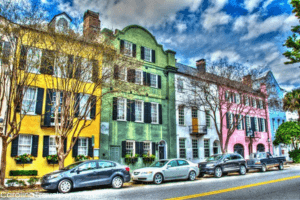
Explore The Historic Landscape of Charleston Landmarks
Charleston’s historic landmarks are rich with stories. One such location is St. Michael’s Episcopal Church, built in 1761 and known for its iconic 186-foot steeple. Witnessing significant American historical moments including both revolutions, civil wars and even famous figures like John Rutledge who signed the United States Constitution is a testament to that fact.
Nathaniel Russell House was constructed in 1808 as an exquisite Neoclassical mansion that perfectly illustrates Charleston’s wealth and elegance during the antebellum period. Inside is exquisite detailing like a cantilevered spiral staircase and ornate plasterwork – giving visitors a look into the life of both the Russell family and those enslaved African Americans who worked there.
Dock Street Theatre stands as another iconic Charleston landmark, first constructed in 1736 as America’s inaugural permanent theater. Since its birth, this historic venue has endured fires, earthquakes, and wars while continuing to host performances and provide cultural space within Charleston.
See also The Best Beaches in Charleston SC: 10 Amazing Spots!Charleston’s historic landmarks each hold their own special story and architectural value, so exploring these sites allows one to step back through time and gain first-hand knowledge of Charleston’s past.
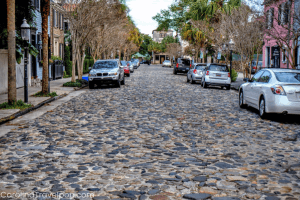
Explore Charleston’s Historic Buildings Architecturally
Charleston’s historic buildings showcase an eclectic variety of architectural styles that reflect its diverse history and influences. One such architectural style, in particular, stands out: Georgian. Characterized by symmetrical facades with evenly spaced windows and classical details – examples being St Michael’s Episcopal Church as well as various grand mansions within Charleston itself, Georgian is particularly prevalent here.
Federal is another prevalent style, distinguished by its simplicity and symmetry. A prime example of Federal architecture in Charleston can be seen at Nathaniel Russell House with its elegant proportions and intricate detailing – it stands as a testament to this trend!
Greek Revival architecture left its mark on Charleston during the mid-19th century, particularly with the Aiken-Rhett House being an outstanding example. Built in the 1820s and featuring grand porticos, columns, and elaborate plasterwork reminiscent of ancient Greek temples; all hallmarks of its style.
Charleston’s architecture also demonstrates the influence of Caribbean and West African architecture, especially Rainbow Row houses with their colorful facades that combine the Caribbean with Georgian architectural styles – these popular tourist destinations date back to 18th-century Charleston!
As you explore Charleston’s historic buildings, take time to appreciate all their intricate details, craftsmanship, and stories they contain – each building serves as an expression of its architectural legacy in Charleston.
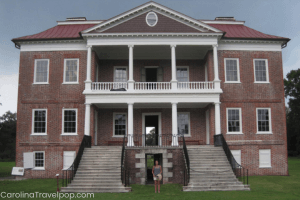
Charleston Is Home to Historic Landmarks and Landmarks
Charleston is known for several iconic historic landmarks that serve as iconic symbols of its beauty. One such location is The Battery, an impressive seawall and promenade along Charleston Harbor that provides stunning views. Lined by grand antebellum mansions, The Battery offers breathtaking panoramas that allow locals and visitors to unwind while taking in all that Charleston offers. This spot serves as an idyllic destination to take in its beauty while relaxing or taking photographs of it!
Rainbow Row, with its colorful houses on East Bay Street, has become an emblematic representation of Charleston. Dating back to 18th-century construction and painted with pastel hues, Rainbow Row attracts photographers and artists.
The Old Exchange Building in Charleston is another iconic attraction. Constructed during the late 18th century, this landmark served variously as a customs house, post office, and prison before eventually becoming a museum showcasing Charleston’s role in both American Revolution and slave trade history.
Fort Sumter in Charleston Harbor, known for being the site of the first shots fired during the American Civil War, is another historic landmark that deserves to be visited. Visitors can take a boat tour out to this fort and tour its grounds while learning more about events leading up to it and its significance in history.
These iconic landmarks encapsulate Charleston’s heritage, making visits here essential for anyone interested in understanding this city’s past.
See also Folly Beach Travel Guide: 9 Spectacular Reasons to GO!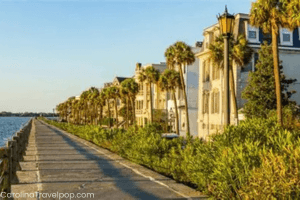
Hidden Gems in Charleston: Lesser-Known Historic Landmarks
Charleston may be known for its iconic landmarks, but there are also lesser-known historic sites worth discovering in Charleston’s historic center that should not go overlooked. These hidden gems provide a more personal and off-the-beaten-path experience of Charleston’s history that should not be missed out.
Heyward-Washington House stands as an iconic example of Charleston’s hidden treasures, nestled into its historic district. Built during the 1770s as the residence for Thomas Heyward Jr. – one of the signers of the Declaration – and later used as an office during Revolutionary War times, its now an open museum that gives visitors a peek into Charleston’s elite life during these turbulent years.
Another hidden treasure nearby the Nathaniel Russell House is the Aiken-Rhett House. While Nathaniel Russell House has been restored with extraordinary care and detail, Aiken-Rhett House remains in its original state providing visitors with an insight into both white owners and African Americans who lived and worked here during its existence.
The Powder Magazine is another gem often missed by visitors to Charleston. Dating back to the early 18th century, this small brick building served as storage of gunpowder during colonial rule; nowadays it serves as a museum that educates guests about Charleston’s military past.
These lesser-known sites may not receive as much publicity as Charleston’s iconic landmarks, yet they provide an unforgettable and authentic experience to those willing to seek them out. Discovering them allows you to uncover hidden stories that shaped Charleston’s history as you find out its story through exploration.
Tourism’s Impact on Charleston Landmarks
Tourism plays an instrumental role in maintaining Charleston’s historic landmarks and sites, helping preserve them for future generations, and supporting efforts to protect and restore these treasures. Each year millions of visitors to Charleston come for its rich heritage and well-preserved sites which play host to millions of guests bringing millions of dollars and dollars for restoration work – not forgetting boosting Charleston’s economy!
However, tourists present challenges to preservation while maintaining accessibility and sustainability. An increase in foot traffic could cause wear-and-tear on historic buildings or sites and must be managed carefully as conservation measures are implemented to preserve landmarks for longer.
Tourism brings economic advantages to cities as it generates revenues that can be reinvested into maintaining and conserving historic sites. Income generated from ticket sales, guided tours, and souvenir purchases helps fund ongoing upkeep and preservation initiatives.
Tourism creates jobs and strengthens local economies, contributing to overall city revitalization. Historic sites frequently partner with vendors and service providers who benefit from tourist influxes by creating networks of businesses that capitalize on them.
Tourism can have an enormously positive effect on Charleston’s historic landmarks; however, for tourism practices to have lasting benefits on conservation efforts it must strike an appropriate balance between accessibility and conservation measures. Implementation of sustainable practices such as restricting visitor numbers, conserving natural areas through conservation initiatives, or supporting responsible travel can go a long way toward safeguarding these treasures for generations to come.
I’ve made a listing of great activities to explore with kids while in Charleston as well!
See also 27 Top Things To Do In Charleston South CarolinaPreserving and Restoring Charleston’s Historic Landmarks
Conservation and restoration of Charleston’s historical landmarks require cooperation among government agencies, non-profit organizations, and the local community. Working together ensures long-term preservation and ensures sustainable future of its heritage.
The Historic Charleston Foundation, for example, is a non-profit organization committed to conserving and protecting Charleston and the Lowcountry’s cultural resources through the acquisition, restoration, and management of historic properties ensuring their preservation for future generations. Furthermore, educational programs and advocacy initiatives aim to heighten awareness about historic preservation.
The City of Charleston’s Board of Architectural Review (BAR) plays an essential role in the preservation and restoration of historic structures. By reviewing proposed changes to buildings within historic districts within Charleston’s limits, BAR ensures any proposed modifications meet city architectural guidelines while not jeopardizing historical fabric.
South Carolina State Historic Preservation Office (SHPO) plays an essential role in Charleston’s preservation. They administer federal and state historic preservation programs while offering technical support to property owners, developers, local governments, and property managers alike. Furthermore, the SHPO oversees the National Register of Historic Places which recognizes significant historic sites or buildings across South Carolina.
Preserving and restoring Charleston’s historical landmarks are critical in assuring future generations can continue to appreciate and learn from these precious resources. By cooperating, stakeholders can protect and safeguard Charleston’s rich architectural history.
Consider joining A Historic Landmark Tour in Charleston
One of the best ways to experience Charleston’s rich past is with a historic landmark tour. These guided excursions provide insights into its past while giving greater context for each landmark’s significance and history.
Numerous tour companies in Charleston provide visitors with various tour options, from walking tours and carriage rides to boat cruises and boat charters. Walking tours are especially popular because they allow visitors to explore Charleston’s historic district while listening to knowledgeable guides share interesting tales and historical insights regarding its landmarks.
Carriage tours provide an enjoyable, leisurely way to see Charleston’s historical sites. Visitors can sit back and take in all that Charleston has to offer from its cobblestone streets; taking in all its sights and sounds along the way! Carriage tour guides also provide commentary about key landmarks as their carriage travels through Charleston’s historic district.
Boat tours provide an ideal way to discover Charleston’s maritime past and its scenic harbor area, offering panoramic views of Fort Sumter.
Taken on foot, carriage ride, or boat tour – taking a historic landmark tour in Charleston can be both a memorable and fulfilling experience. By delving deeper into its stories and history while appreciating the architectural beauty of landmarks.
Wrap-Up: Historical sites in Charleston South Carolina
Charleston’s historic landmarks serve as living reminders of those events that have helped form Charleston. Ranging from grand mansions to cobblestone streets, each landmark tells its tale and showcases Charleston’s glorious past.
Preserving and celebrating these landmarks are integral to protecting Charleston’s cultural identity and heritage. By understanding and appreciating Charleston’s past, we can gain a greater appreciation of present-day treasures that still deserve protection for future generations.
Get on your walking shoes, grab a guidebook, and set out on an exciting exploration of Charleston! Explore iconic sites, uncover hidden gems, and take a historic landmark tour to fully experience Charleston’s rich history – embrace stories and beauty that these landmarks hold and be taken back through time to an era where colonial influences and Southern charm interweave! Don’t wait; start discovering Charleston today!

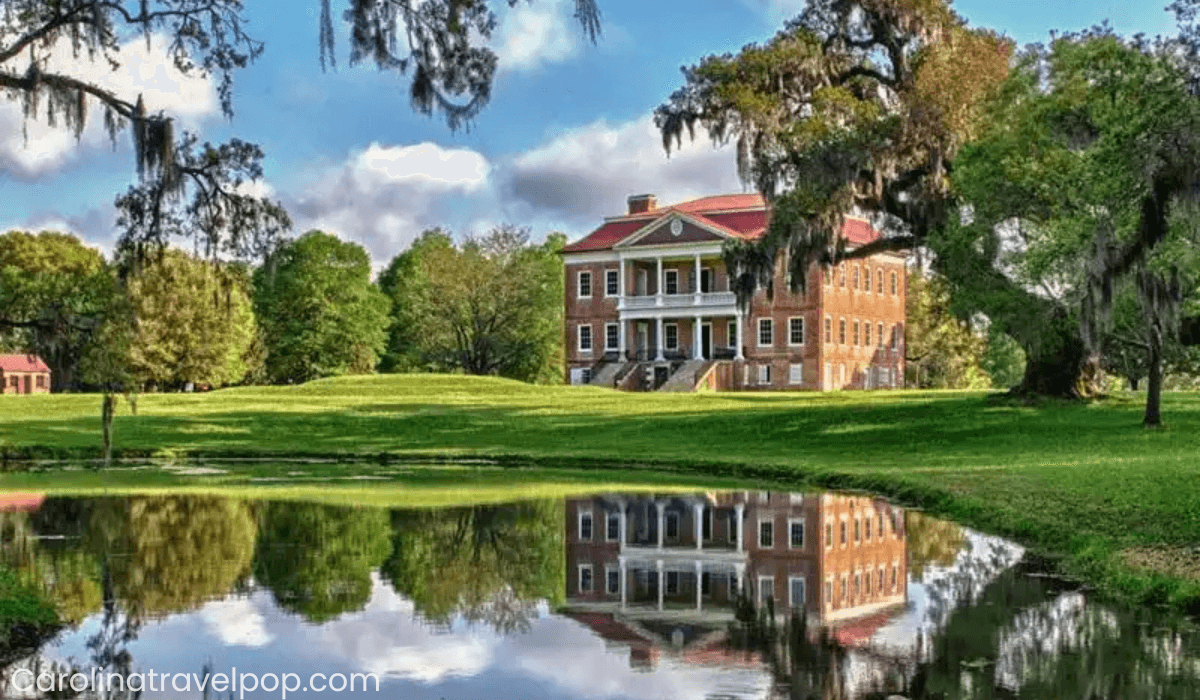
1 thought on “17 Must-Visit Historical Sites in Charleston South Carolina”